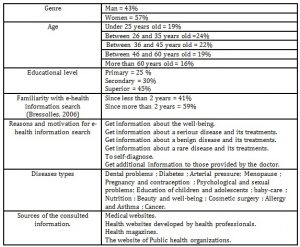Introduction
Using the Internet tool to search for information related to health has become a trivial matter with the huge number of web sites dealing with health. People who wish to learn about their health conditions are no longer obliged to go to the doctor’s. In fact, doctors are no longer the only source of information which is now available to the public with a few clicks (Romeyer, 2012).
The current enthusiasm for this practice is primarily accounted for by cost considerations, the unavailability of medical staff, and the quick access to health information. However, this easy access to information raises a serious problem as to the credibility of the data, the impact on individual behavior, decision making and the different types of treatments (Goetzinger et al., 2007). Besides, the risk inherent to a misinterpretation of the collected information is particularly important when the purpose of this practice is to replace medical advice, to confirm or to deny a medical diagnosis.
These findings led us to focus on the perceived quality of the information related to health as an element that reduces the risks inherent to a framework of e-health information search. More precisely, this consists, first, in considering the role played by the quality of online health information in reducing risk perceptions. Second, in identifying the main components of the perceived risk of the behavior related to online health information search. And third, in studying the role of the perceived quality of information in reducing risks and in developing intentions that are favorable to this type of behavior.
We will hereafter start with a presentation of the conceptual framework of the research. We will then present the research methodology and the results of the empirical study. We will conclude with a discussion of the main findings, contributions, limitations and future research tracks.
Conceptual background
Perceived Risk
The introduction of the concept of perceived risk in the field of consumer behavior has emerged with the works of Bauer (1960). The latter stipulates that consumer behavior is an example of a risk-taking behavior, a behavior to reduce risk (Ben Naoui, 2014), and an important explanatory factor in the decision-making process (Lehu, 2004).
A review of the literature related to the different definitions of the concept of perceived risk allowed us to notice that there is some divergence concerning the set of its different facets and components and its different types. However, researchers agree on integrating the notions of loss, uncertainty and the potential consequences of this loss in their definitions of perceived risk. Volle (1995), for instance, has defined perceived risk as “the perception of uncertainty related to the negative effects that are potentially associated with an alternative choice”. According to Dholakia (1997), it is the set of subjective expectations of a potential loss associated with a variation of choice. It is a set of perceptions of uncertainty and unfavorable consequences associated with engagement in a given activity (Grazioli and Wang, 2001). Besides, and based on the assumption stating that any purchase decision involves the perception of a risk or an uncertainty (Barach, 1969), risk has been associated with anxiety by many researchers such as Cox (1967), Jacoby and Kaplan (1972), and Menvielle et al. (2010).
The integration of consequences, whether negative and / or positive, in the definitions and conceptualizations of perceived risk raises a number of questions. Indeed, some researchers only acknowledge the negative consequences in their conceptualizations of risk (Gabott, 1991; Volle, 1995; Dholakia, 1997; Grazioli and Wang, 2001; Ouzaka, 2001), others opt for both at the same time (Mayer et al., 1995; Kim and Prabhakar, 2000; Jarvenpaa et al., 2000; Gefen et al, 2003b; Lendrevie et al., 2003; Lehu, 2004).
In addition to the limitations mentioned above, several researchers, including Jacoby and Kaplan (1972), have criticized the classical risk division into two parts, and discussed the multidimensional nature of perceived overall risk. Hence, several types (or dimensions) of risk have been identified. The main among these are the following:
- Performance risk: It is related to a potential loss of the functional characteristics of the product (Brunel, 2002), a failure of the purchased item (Brunel, 2002; Laroche et al., 2004), and the difficulty of judging the quality of the product (Bezes, 2012).
- Financial risk: It is a financial loss following the purchase of a product (Laroche et al., 2004) that can be generated by a sense of loss of earnings caused by a cheaper selling price elsewhere (Bezes, 2012).
- Psychological risk: It is the loss of one’s image of oneself or of one’s principles (Murray and Schlacter, 1980; Laroche et al., 2004) caused by the purchase of a product (Bezes, 2012).
- Time risk: It is a waste of time associated with the purchase decision (Lendrevie et al., 2003; Laroche et al., 2004.), with the failure of a purchased product (Bezes 2012, Roselius 1971 cited in Brunel, 2002).
- Social risk: It is a loss of self-esteem caused by the reaction of one’s immediate environment (Murray and Schlacter, 1980; Laroche et al., 2004; Bezes, 2012).
- Physical risk: It is the physical damage caused by a purchase act (Brunel, 2002; Bezes 2012).
We mention, however, that other types of risk have been identified in an electronic environment, namely the risk associated with the digital environment dealt with in the works of Ratnasingham and Pavlou (2003); Verhagen et al. (2004; 2006), and the information risk in the works of Laroche et al. (2004); Bart et al. (2005); Pennanen (2009).
Relying on the conceptualization of Stone and Gronhaug (1993); Laroche et al., (2004), perceived risk is considered as a subjective expectation of loss that is composed of financial risk, performance risk, time risk, social risk and psychological risk. However, in a context of an online health information search, the financial risk is neither appropriate nor relevant. Besides, this facet of risk is very important in the case of online shopping (Bobitt and Dabholkar, 2001). Consequently, perceived risk is composed of the following dimensions:
– Psychological risk: It is the loss of the image one has of oneself or of one’s principles (Murray & Schlacter, 1980; Laroche et al., 2004) due to e-health information search.
– Time risk: It is a waste of time associated with e-health information search.
– Social risk: It is a loss of self-esteem caused by the reaction of the immediate environment (Murray and Schlacter, 1980; Laroche et al., 2004; Bezes, 2012).
– Performance risk: A functional risk related to e-health information search.
Information Perceived Quality
In order to ensure the success of their businesses, professionals are compelled to minimize the various risks by adopting appropriate strategies to reassure and keep their current customers and to win new potential customers. As a matter of fact, the literature has stressed a panel of risk-reducing strategies. One of these strategies consists in building an environment of trust and loyalty, in working on reputation, image and brand awareness, and on labeling the product by legal organizations.
Researchers most frequently cite the classification of the different types of risk reducers identified by Mangold et al. (1987). They made a distinction between personal reducers, such as advice from a salesperson, an expert, friends, family members, or mere word-of-mouth, and impersonal reducers like commercial advertisements. In addition to these two categories and based on the works of Cases (2001), Mitchell and McGoldrick (1996); Menvielle et al. (2012) referred to a different type of reducers, involving previous experience and testing.
To reduce the perceived risks related to any situation in general, or to a purchase act in particular, consumers rely on the search for information that is provided by the various risk reducers mentioned above and which are based, in the sense of Gronhaug et al. (2001, cited in Brunel, 2002) on “objective, subjective and experiential knowledge”. As a matter of fact, perceived risk has been likened to an “activating factor” of information search (Brunel, 2002), notably in the works of Cox (1967); Urban et al. (1989); Bearden and Shimp (1982); Dowling and Staelim (1994). Similarly, the search for information has been considered as a strategy to reduce perceived risk (Brunel, 2002).
In the context of e-marketing, many research works showed that these two concepts are closely related. Indeed, researchers have focused their attention on stressing the important role of the quality of online information in reducing perceived risks (examples comprise the works of Nicaulou and McKnight, 2006; Flanagin, 2007; Adjei et al., 2010; Hallem et al., 2013; etc.). The matter specifically amounts to identifying the criteria of information integrity and the credibility of its sources. According to Boritz (2004), for example, the quality of the perceived information is judged on its accuracy, timeliness, and completeness. In addition to these criteria, Bovee (2004) added the criteria of accessibility, clarity and comprehensibility.
In our research work, the perceived quality of the information will be considered as “a comprehensive judgment, an attitude or a reaction to the superiority of the sought information” (Ben Naoui and Zaiem, 2015). It will be assessed on two main aspects as identified by Maltz (2000), namely the relevance of the information (which refers to the timeliness, accuracy and completeness of information) and the clarity of the information (which refers to the accessibility and comprehensibility of information) (Ben Naoui and Zaiem, 2015).
The Research Hypothesis
Relying on the works of Nicaulou and McKnight (2006); Flanagin (2007); Adjei et al. (2010); Hallem et al. (2013), which showed that the perceived quality of online information has a significant and negative effect on perceived risk, we state the first research hypothesis H.1 which stipulates that “The perceived quality of online information has a negative and significant impact on the perceived risk related to e-health information search “. The sub-hypotheses which emerged from this hypothesis state that the perceived quality of online information has a negative and significant impact on each type of perceived risk identified in a framework of e-health information search:
H.1(1): “The perceived quality of online information has a negative and significant impact on the time risk related to e-health information search “.
H.1(2): “The perceived quality of online information has a negative and significant impact on the psychological risk related to e-health information search “.
H.1(3): “The perceived quality of online information has a negative and significant impact on the social risk related to e-health information search “.
H.1(4): “The perceived quality of online information has a negative and significant impact on the performance risk related to e-health information search “.
Previous research works have largely emphasized the important role of the perceived quality of online information in the development of favorable intentions, attitudes and behaviors (Nicaulou and McKnight, 2006). Indeed, Lee et al. (2009) studied the effect of the information seekers’ motivations on e-health information quality. Their empirical results have identified the motivations to search e-health information and have confirmed that there is a significant relationship among the information perceived quality, the satisfaction and the intention to repeat searches for e-health information. Besides, Yaşin and Özen (2011) showed that the perceived benefits, the perceived quality and the reliability of e-health information affect the intention to repeat e-health information search.
Hence, the second hypothesis of this study will be worded as follows: H.2 “The perceived quality of online information has a positive and significant impact on the intention to repeat e-health information search”.
Previous research works have shown that perceived risk has a negative influence on the intentions, attitudes and behaviors of Internet users (Jarvenpaa et al., 2000; Pavlou, 2003; Nicoulau and McKnight, 2006; Chang and Chen, 2008; Hallem et al., 2013). This will allow us to state our third hypothesis H.3: “Perceived risk has a negative and significant impact on the intention to repeat e-health information search”.
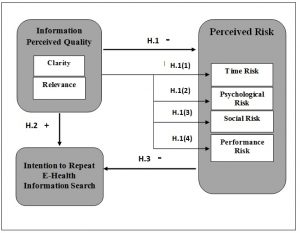
Figure 1: Conceptual framework
Methodology
We conducted an online survey. In the message sent to the participants, we kindly required health professionals not to participate.
The online survey has three main parts. The first part includes questions about the gender, the age, the level of education and profession of the respondent and its past experiences with e-health information search. It also includes questions about the main reasons and motivations for respondents to learn about their health and well-being on the Internet, about the different types of the searched information and diseases, and, finally, about the different sources of the consulted information.
The second part is dedicated to the measure of the perceived risk related to e-health information search. Hence, we adapted the conceptualization of Stone and Gronhaug (1993); Laroche et al., (2004) in the context of an online health information search. The third part includes questions about information perceived quality and intentions to repeat e-health information search. We used the two-dimensional scale of Maltz (2000) as a measure of the information perceived quality. We equally measured the intention to repeat the online search for health information by the scale of Rundle-Thiele (2005, cited in Goetzinger et al., 2007).
We finally collected 250 filled-in questionnaires from Internet users seeking information about their health status and/or well-being, or from people who are already suffering from a disease and who want to learn and gather additional information other than what their doctors told them (see Appendix 2, table 4).
Empirical Study
In order to validate the measurement scales, we used, first, an exploratory factor analysis (EFA), and then, a confirmatory factor analysis (CFA) through the structural equations method (SEM). To estimate the variables, we used the maximum likelihood method (ML) that requires the respect of the multi-normality. However, this condition has not been verified in our case. Consequently and in order to correct this problem, we used solutions recommended by Akrout (2010).
The reliability at an exploratory level was checked with the Cronbach’s Alpha index. The reliability at a confirmatory level was verified with the Rhô of Jöreskog index. Their values should be superior to the 0.6 threshold set by Bagozzi and Yi (1988, cited in Akrout, 2010). And in order to verify the convergent and discriminant validity, we used the Fornell and Larker (1981) approach. Indeed, the values of convergent validity indices should be superior to the 0.5 threshold advocated by Roussel et al. (2002), and finally values of extracted variances should be higher than the square of the correlation between the dimensions of the concept.
Reliability and validity of the perceived risk measurement scale
The results of an exploratory factor analysis (EFA) with principal components analysis (varimax rotation), conducted on the perceived risk measurement scale, led us to conclude that the scale of perceived risk has a four-dimensional factorial structure. The Cronbach’s alpha index superior to 0.8 (Evrard et al., 2003) and show a good internal consistency of the scale.
Table 1: The EFA results of the perceived risk measurement scale
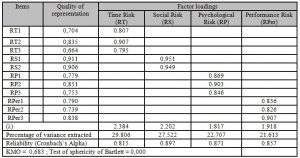
In addition to the EFA, we conducted a CFA to verify the quality of fit of the measurement model of perceived risk and to check its good reliability and validity. The results of a first CFA showed that the contributions of the social risk and the performance risk have no significant effect on the perceived risk (CR = 1.576, p = 0.117, SMC = 0.003 and CR = 1.769, p = 0.137, SMC = 0.005). Therefore, the perceived risk involved in e-health information search is a two-dimensional concept consisting of the psychological risk (the potential loss of the image of oneself or of one’s principles (Murray and Schlacter, 1980; Laroche et al., 2004) due to e-health information search) and the time risk (a waste of time associated with e-health information search).
A second CFA was achieved without these dimensions. Results show that the data normality hypothesis was not tested (the Mardia index = 15.053> 3). To overcome this problem, we started by eliminating observations with the highest Mahalanobis distances. As we reached no satisfying results, we turned to the procedure of Bollen Stine Bootstrap by comparing the difference between the probability of chi-square model without bootstrap and the one with bootstrap which was insignificant.
In addition and in order to check the stability of the data, we compared the values of the parameters reached through the ML method to those reached with the bootstrap method (N = 250). The difference between the average of factor weights calculated by bootstrap and that of factor weights calculated without bootstrap was slight (below 0.01). Thus, the results interpreted are the ones provided by the ML method.
The measurement model of the perceived risk presents satisfactory fit indices, as shown in Table 2. In addition, the scale is reliable with values of the Rhô of Jöreskog equal to 0.823 for the time risk and equal to 0.873 for the psychological risk. The Rhô values of the convergent validity are equal to 0.610 for the time risk and equal to 0.698 for the psychological risk. And finally, the values of extracted variances are higher than the square of the correlation (0.356) between the two dimensions. This confirms the discriminating validity of the measurement scale of perceived risk.
Table 2: The perceived risk model fit indices

Reliability and validity of the information perceived quality measurement scale
To check the psychometric properties of the measurement scale of information perceived quality, we followed the same approach used previously. The EFA results, summarized in tables 4, show a two-dimensional structure of the scale with acceptable values of the Cronbach’s Alpha.
Table 3: The EFA results of the information perceived quality measurement scale.
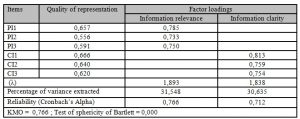
In addition to the EFA, we conducted a CFA to verify the quality of fit of the measurement model of information perceived quality and to check its good reliability and validity. The CFA results reveal a violation of the data normality assumption (the Mardia index is superior to 3). To make up for this problem, we followed the same approach used previously.
The violation of normal distribution did not have any effect on the results because the difference between the probabilities of the model’s Chi-square without bootstrap and its probability with bootstrap was below 0.01. Besides, we interpret the results reached through the ML method because the difference between the estimated values of the parameters of the ML method to those of the bootstrap method was insignificant.
The fit indices measuring the information perceived quality model are satisfactory (chi-square/dl = 3.536; GFI = 0.980, AGFI = 0.898; RMR = 0.023; RMSEA = 0.027; NFI = 0.977; CFI = 0.981; TLI = 0.944). We also checked the reliability at the confirmatory level with the Rhô of Jorekög index and the validity of each of the dimensions of information perceived quality using the approach of Fornell and Larker (1981).
The CFAs results confirm reliability at the exploratory and confirmatory level as well as convergent and discriminating validity. Indeed, the value of the Rhô of Jöreskog is equal to 0.766 for the information relevance and equal to 0.798 for the information clarity. The Rhô value of the convergent validity is equal to 0.629 for the information relevance and equal to 0.668 for the information clarity. And finally, the values of extracted variances are higher than the square of the correlation (0.464) between the two dimensions.
Reliability and validity of the intention to repeat E-health information search measurement scale
An EFA conducted on the scale of the intention to repeat E-health information search led us to conclude that the scale has a one-dimensional factor structure. The Cronbach’s Alpha (0.980) reveals a good internal consistency of the scale. Besides, the CFAs results confirm the reliability, with a value of the Rhô of Jöreskog equal to 0.854, and the convergent validity with a value of the Rhô of the convergent validity equal to 0.695.
Table 4: The EFA results of the intention to repeat E-health information search
measurement scale.

Reliability and validity of the global measurement model
In order to resolve issues related to the violation of data normality (the Mardia index exceeds 3) and to check the robustness of our model, we used the Bootstrap procedure (N = 250). As the differences between the values of the parameters estimated by the ML method and those of the bootstrapped samples were not significant, we relied on the results reached through the ML method.
The global measurement model presents satisfactory fit indices as shown in table 5. Indeed, the AGFI and NFI indices are slightly lower than 0.9. The GFI, TLI and CFI indices are above 0.9. The RMR and RMSEA indices have low values. Finally, the model meets the parsimony conditions with a Chi-square value of 1.610. We checked, also, the reliability at the confirmatory level and the convergent and discriminant validity using the approach of Fornell and Larker (1981) (see table 6 and 7).
Table 5: The global measurement model fit indices

Table 6: Reliability and convergent validity of the variables of the global measurement model

Table 7: The discriminant validity of the measurement model

Causal Model and Hypothesis Tests
The causal model has a satisfactory fit quality (chi-square/dl = 1.610; GFI = 0.918; AGFI = 0.885; RMR = 0.048; RMSEA = 0.043; NFI = 0.896; CFI = 0.957; TLI = 0.915). To test and validate the research hypothesis, we used the Structural Equations Method. The results of the causal links between variables are summarized in Table 8. Structural links are significant at the 5% threshold, and the absolute values of the Student tests are above 1.96. This allowed us to validate the research hypothesis H.1, H.2, H.3, H.1(1) and H.1(2). The hypothess H.1(3) and H.1(4) are not validated because the contributions of social risk and performance risk have no significant effect on perceived risk and therefore, they aren’t considered as facets of perceived risk in the case of e-health information search.
Hence, the information perceived quality has a significant and negative impact on the perceived risk and a significant and positive impact on the intentions to repeat e-health information search. Moreover, perceived risk has a negative impact on the intentions to repeat e-health information search. Finally, the information perceived quality has a significant and negative impact on both facets of perceived risk as identified in a framework of e-health information search, i.e. time risk and psychological risk.
Table 8: The research hypothesis tests
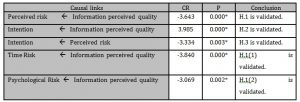
Results and Discussions
Throughout this research, we tried to answer three main objectives. First, we tried to identify the different facets of the overall perceived risk involved in a framework of e-health information search. Second, we examined the role of information perceived quality in reducing different facets of risk as identified in a framework of e-health information search. Third, we assessed the impact of the information perceived quality and that of perceived risk on the intention to repeat e-health information search.
To reach these objectives, we conducted an empirical study using an online questionnaire. We targeted Internet users who are seeking information about their health status and/or well-being by inviting them on a social network and by sending e-mails relying on our address books and those of our friends and relatives.
Relying on the conceptualization of Gronhaug and Stone (1993); Laroche et al. (2004), we showed, through empirical results, that the overall perceived risk related to e-health information search consists of time risk and psychological risk. The former refers to a possible loss of time associated with an act of e-health information search. The latter is a potential loss of self-image caused by this act.
The empirical results revealed that the information perceived quality can reduce the levels of perceived risks related to e-health information search. It can precisely reduce the risks related to a loss of time and loss of self-esteem caused by e-health information search. As a matter of fact, previous literature has always associated risk reduction with search for information (Dowling and Staelim, 1994) and several studies proved that the quality of information online has a negative impact on perceived risks, as shown, for instance, in the works of Nicaulou and McKnight (2006); Flanagin (2007); Adjei et al. (2010); Hallem et al. (2013).
Moreover, it turned out that the intention to repeat e-health information search is accounted for positively by the perceived quality of information related to health and is explained negatively by perceived risk. Thus, a high level of information perceived quality favors the development of positive attitudes and behavior towards the use of the Internet tool in the search for information on health and/or well-being. These results converge with those in the literature, notably the works of Nicaulou and McKnight (2006). Similarly, a high level of perceived risk has a negative impact on the intentions, attitudes and behaviors of Internet users. These results are in agreement with the works of Pavlou (2003); Nicoulau and McKnight (2006); Chang and Chen (2008); Hallem et al. (2013).
Contributions, limitations and Future Research
The main theoretical contribution of our research is to identify the major components of perceived risk related to conducting online research to get health information. It is also the investigation of the role of perceived quality of information in reducing risk and developing intentions that are favorable to this type of behavior.
Identifying the aspects of the perceived risk associated with this practice is interesting as it will probably influence the actions and marketing strategies adopted by the designers of health websites and healthcare professionals working online. Indeed, professionals must give importance to the psychological and temporal aspects of risk in order to take the necessary measures to minimize uncertainties and reassure Internet users seeking health information online. Consequently, websites must be designed according to the logic of Internet users who feel anxious about the potential waste of time and loss of their images and principles resulting from e-health information search.
In this case, professionals must act on the technical aspects of the site as well as on its content. This amounts to developing tools and mechanisms to facilitate navigation on the site and to providing friendly access to information. As for the content of the site, it must be treated in a way to make it attractive, rich, varied, understandable and regularly updated. Thus, the dilemma is about how to provide balance between the completeness, accuracy and comprehensibility of the information on one side, and the timeliness, clarity and accessibility of this information, on the other hand.
Our research has some limitations related to the conceptualization of the perceived quality of information that has not taken into consideration the effect of the credibility of the source. Indeed, we measured the IPQ according to its relevance and clarity, while in reality, the credibility of the source of information is an important indicator of the relevance of this information. It would have been interesting to include this element in the overall judgment of the information quality.
References
- Adjei, MT., Noble, SM. and Noble, CH. (2010), ‘The influence of C2C communications in online brand communities on customer purchase behavior’, Journal of the Academy of Marketing Science, 38, 634-653.
- Akrout, F. (2010), Les méthodes des équations structurelles, 1st Edition, Unité de Recherche en Marketing, 2010.
- Bagozzi, RP. and Yi, Y. (1988), ‘On the evaluation of structural equation model’, Journal of The Academy of Marketing Science, 16, 74-94 cited in Akrout, F. (2010), Les méthodes des équations structurelles, 1st Edition, Unité de Recherche en Marketing.
- Bauer, R. (1960), Consumer Behavior as risk taking, Dynamic Marketing for a Changing World, RS. Hancock (ed.), American Marketing Association, 389-398.
- Barach, JA. (1969), ‘Advertising effectiveness and risk in the consumer decision process’, Journal of Marketing Research, 6(3), 314-320.
- Bart, Y., Shankar, V., Sultan, F. and Urban, GL. (2005), ‘Are the drivers and role of online trust the same for all web sites and consumers? A large scale exploratory empirical study’, Journal of Marketing, 69, 133-152.
- Bearden, WO. and Shimp, TA. (1982), ‘The use of extrinsic cues to facilitate product adoption’, Journal of Marketing Research, 9, May 1982, 229-239.
- Ben Naoui, F. and Zaiem, I. (2015), ‘La réduction des risques perçus liés à la recherche en ligne des informations relatives à la santé : Les rôles de la qualité perçue de l’information et la confiance institutionnelle’, Proceedings of the 25th Inernational Business Information Management Association (IBIMA), 7-8 May 2015, Amsterdam, Nedherland.
- Ben Naoui, F. (2014), ‘La formation de la confiance envers un site web informative et son effet sur les réactions des internautes : Une approche intégrant la qualité d’un service en ligne et les caractéristiques individuelles’, Thesis, High Business School of Tunisia, 10 Novembre 2014.
- Bezes, C. (2012), ‘Risque perçu et réduction de risqué d’achat en ligne et en magasin: Le cas FNAC’, 11th International Marketing Trends Conference, Venise, 2012.
- Bobitt, LM. and Dabholkar, PA. (2001), ‘integrating attitudinal theories to understand and predict use of technology-based self service’, International Journal of Service Industry Management, 12(5), 423-450.
- Boritz, E. (2004), ‘Managing Enterprise Information Integrity: Security, Control and Audit Issues’, IT Governance Institute, Rolling Meadows, IL.
- Bovee, MW. (2004), ‘Information Quality: A Conceptual Framework and Empirical Validation’, D. Dissertation, University of Kansas.
- Brunel, O. (2002), ‘Les stratégies d’ajustement au risque alimentaire : Modèle théorique et test empirique’, Thesis, 4 Dec. 2002.
- Cases, AS. (2001), ‘La réduction du risque dans le contexte de l’achat électronique sur Internet’, PhD Thesis, University of Montpellier II.
- Chang, HH. and Chen, SW. (2008), ‘The impact of online store environment cues on purchase intention, trust and perceived risk as mediator’, Online Information Review, 32(6), 818-841.
- Cox, DF. (1967), Risking taking and information handling in consumer behavior, (Ed). BOSTON, Harvard University Press.
- Dholakia, UM. (1997), ‘An investigation of the relationship between perceived risk and product involvement’, Advances in Consumer Research, 24, 159-167.
- Dowling GR. and Staelim, R. (1994), ‘A model of perceived risk and intended risk-handling activity’, Journal of Consumer Research, 21(1), 119-134.
- Evrard, Y., Pras, B. and Roux, E. (2003), Market Etudes et recherché en marketing, 3rd Edition, Dunod, Paris.
- Flanagin, A J. (2007), ‘Commercial markets as communication markets: uncertainty reduction through mediated information exchange in online auctions’, New Media and Society, 9(3), 401-423.
- Fornell, C., D. and Larcker, (1981), ‘Evaluating structural equation models with unobservable variables and measurement error’, Journal of Marketing Research, 18, 39-50.
- Gabott, M. (1991), ‘The role of product cues in assessing risk in second-hand markets’, European Journal of Marketing, 25(9), 38-50.
- Gefen, D., Srinivasan RV. and Tractinsky, N. (2003b), ‘The Conceptualization of Trust, Risk and Their Relationship in Electronic Commerce: The Need for Clarifications’, in Proceedings of the 36th Hawaii International Conference on System Sciences.
- Goetzinger, L., Park, J., Lee, YJ. and Widdows, R. (2007), ‘Value-driven consumer e-health information search behavior’, International Journal of Pharmaceutical and Healthcare Marketing, 1(2), 128-142.
- Grazioli, S. and Wang, A. (2001), ‘Looking without seeing: Understanding unsophisticated consumers’ success and failure to detect internet deception’, Proceedings of the ICIS 2001.
- Gronhaug, K., Hem, L. and Lines, R. (2001), ‘Perceived product category risk, similarity, consumer knowledge and brand reputation in brand extensions: Further empirical results’, Journal of Brand Management, 9(6), 463-476 cited in Brunel, O. (2002), ‘Les stratégies d’ajustement au risque alimentaire : Modèle théorique et test empirique’, Thesis, 4 Dec. 2002.
- Hallem, Y., Barth, I. and Triki, A. (2013), ‘Comprendre le rôle paradoxal d’internet dans le développement des services medico-touristiques : une étude empirique’, In proceedings of the 12th Days of E-Marketing, France.
- Jacoby, J. and Kaplan, L. (1972), ‘The component of perceived risk’, Third Annual Conference of the Association for Consumer Research, 382-393.
- Jarvenpaa, SL., Tractinsky, N. and Vitale, M. (2000), ‘Consumer Trust in an Internet Store’, Information Technology and Management, 1(12), 45-71.
- Kim, K. and Prabhakar, B. (2000), ‘Initial trust, perceived risk, and the adoption of internet banking’, Proceedings of ICIS 2000.
- Laroche, M., McDougall, GHG., Bergeron, J. and Yang, Z. (2004), ‘Exploring How Intangibility Affects Perceived Risk’, Journal of Service Research, 6(4), 373-389.
- Lee, YJ., Park, J. and Widdows, R. (2009), ‘Exploring antecedents of consumer satisfaction and repeated search behavior on e-health information’, Journal of Health Communication, 14(2), 160-173.
- Lehu, JM. (2004), L’encyclopédie du Marketing, (Ed) Organisation, Paris.
- Lendrevie, J., Levy, J. and Lindon, D., (2003), Mercator, (Ed) Dalloz.
- Maltz, E. (2000), ‘Is all communication created equal? An investigation into the effects of communication mode on perceived information quality’, Journal of Product Innovation Management, 17(2), 110-127.
- Mangold, GW., Berl, R. and Abercombie, CL. (1987), ‘An analysis of the consumer reliance on personal and non personal sources of professional service information’, Journal of Professional Services Marketing, 2(3), 9-29.
- Mayer, RC., Davis, JH. and Schoorman, DF. (1995), ‘An integrative model of organizational trust’, Academy of Management Review, 20(3), 709-734.
- Menvielle, L., Menvielle, W. and Tournois, N. (2010), ‘Vers une compréhension du comportement d’achat de forfaits médicaux à l’étranger : Une approche exploratoire par la méthode du Soft-laddering auprès de consommateurs français et québécois’, 1st International Day of Health Marketing, 25 Nov. 2010, Lille, France.
- Mitchell, VW. and McGoldrick, PJ. (1996), ‘Consumers’ Risk-reduction strategies: A review and synthesis’, The International Review of Retail, Distribution and Consumer Research, 6(1), 1-33.
- Murray, KB. and Schlacter, JL. (1990), ‘The impact of services versus goods on consumer’s assessment of perceived risk and variability’, Journal of The Academy of Marketing Science, 18(1), 51-65.
- Nicolou, AI. and McKnight, HD. (2006), ‘Perceived information quality in data exchanges: effects on risk, trust, and intention to use’, Information Systems Research, 17(4), 332-351.
- Ouzaka, I. (2001), ‘Implication et risque perçu: Ambigüité conceptuelle ou problème de mesure’, CEROG, W.P., N°607, Mai 2001, 1-22.
- Pavlou, P.A. (2003), ‘Consumer Acceptance of Electronic Commerce: Integrating Trust and Risk with the Technology Acceptance Model’, International Journal of Electronic Commerce, 7(3), 101-134.
- Pennanen, K. (2009), ‘The Initial Stages of Consumer Trust Building in e-Commerce A Study on Finnish Consumers’, Business Administration Marketing, Acta Wasaensia N° 201.
- Ratnasingham, P. and Pavlou, PA. (2003), ‘Technology trust in Internet-based interorganizational electronic commerce’, Journal of Electronic Commerce in Organizations, 1(1), 17-41.
- Romeyer, H. (2012), ‘La santé en ligne : Des enjeux au-delà de l’information’, Communication média et santé.[online], 30(1), [retrieved January 15, 2015], www.communication.revues.org/2819.
- Roselius, T. (1971), ‘Consumer rankings of risk reduction methods’, Journal of Marketing, 35(1), 56-71 cited in Brunel, O. (2002), ‘Les stratégies d’ajustement au risque alimentaire : Modèle théorique et test empirique’, Thesis, 4 Dec. 2002.
- Roussel, , Durrieu, F., Campoy, E., and El Akermi, A., (2002), Méthodes d’équations structurelles : Recherches et applications en Gestion, Editions Economica, Paris.
- Rundle-Thiele, S. (2005), ‘Elaborating customer loyalty: exploring loyalty to wine retailers’, Journal of Retailing and Customer Services, 12 (5), 333-344 cited in Goetzinger, L., Park, J., Lee, YJ. and Widdows, R. (2007), ‘Value-driven consumer e-health information search behavior’, International Journal of Pharmaceutical and Healthcare Marketing, 1(2), 128-142.
- Stone, RN. and Gronhaug, K. (1993), ‘Perceived Risk : Further considerations for the marketing discipline’, European Journal of Marketing, 27(3), 39-50.
- Urban, JE., Dickson, PR. and Wilkie, WL. (1989), ‘Buyer uncertainty and information search’, Journal of Consumer Research, 1(6), 208-215.
- Verhagen, T., Tan, Y. and Meents, S. (2004), ‘An Empirical Exploration Of Trust And Risk Associated With Purchasing At Electronic Marketplaces’, in Proceedings of the 17th Bled E-Commerce Conference, Slovenia, 21–23rd June 2004.
- Verhagen, T., Meents, S. and Tan, YH. (2006), ‘Perceived risk and trust associated with purchasing at electronic marketplaces’, European Journal of Information Systems, 15, 542–555 .
- Volle, P. (1995), ‘Le concept de risque perçu en psychologie du consommateur : antécédents et statut théorique’, Recherche et Applications en Marketing, 10(1), 39-56.
- Yaşin, B. and Özen, H. (2011), ‘E-health information search intentions of Turkish internet users’, International Journal of Pharmaceutical and Healthcare Marketing, 5(2), 135-152.
Appendix
Appendix 1: Measurement scale
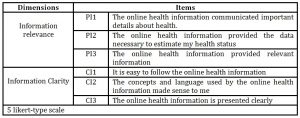
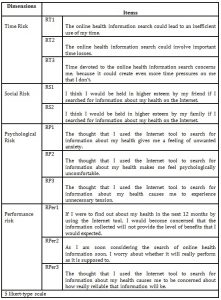

Appendix 2
Table 4: Sample Description
